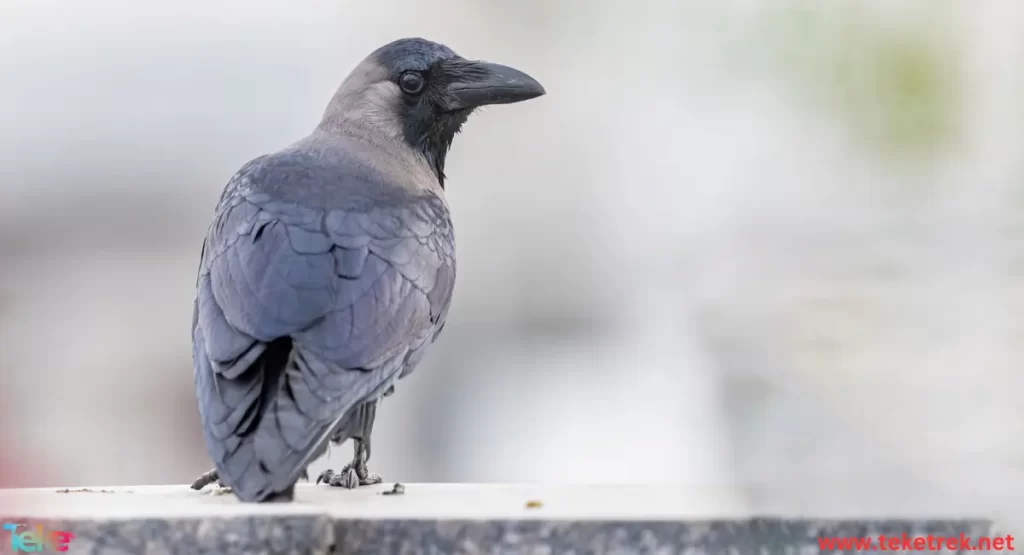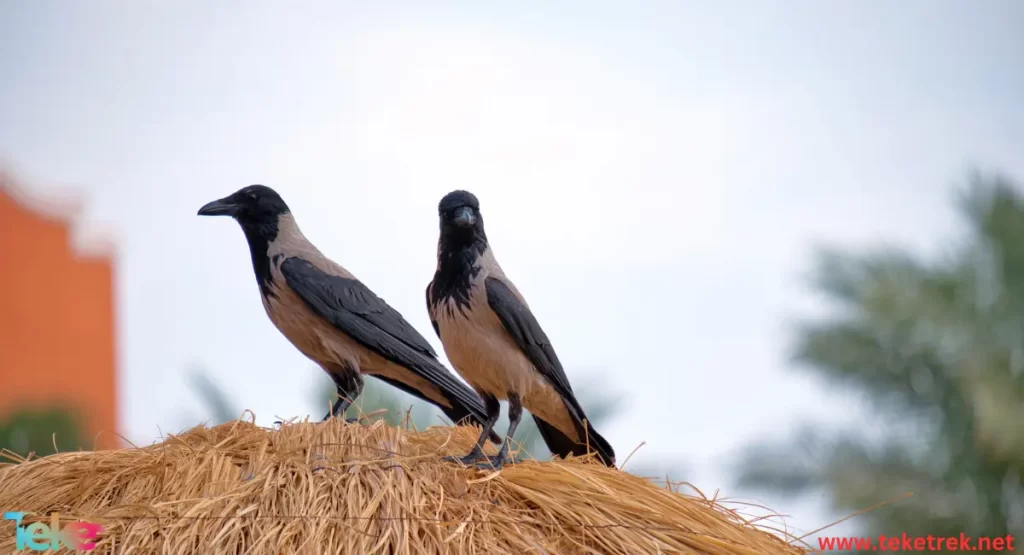The Indian crow (Indian dory crow) is one of the types of crows spread around the world, known by everyone for its distinctive voice and color. But what many people do not know is that there are many types of it, each of which has features and characteristics that distinguish it from other types.
It is called several names, including the Indian Dory Zag, the Ceylon Zag, or the Gray-necked Zag, in reference to the color of its neck, as the multiplicity of names goes back to the places where it spread around the world. Which we will talk about in detail in this article.
In this article from teke trek, we will also talk about its method of reproduction, nutrition, and description, so follow this article with us and devote enough time to reading it and benefiting from the information contained in it.

An introduction to the Indian crow
The Indian crow is widespread in many places around the world, with a widespread distribution in South Asia.
It is native to Nepal, Bangladesh, India, Pakistan, Sri Lanka, the Maldives, the Laccadive Islands, as well as southwestern Thailand and southern coastal Iran.
The Indian crow can be seen in East Africa around Zanzibar and Port Sudan. It also arrived in Australia by ship, but was exterminated and killed due to the damage it caused in those areas. It has also spread to Europe and has been breeding in the city of Hoek in the Netherlands since 1998.
The Indian crow has also been found in some Arab countries and coastal cities overlooking the Red Sea and the Arabian Gulf, and was recorded in the Saudi city of Dhahran for the first time in 1980.
The Indian crow belongs to the Chordata family, from the class of birds.
What are the characteristics of the Indian crow?
The Indian crow is characterized by a set of characteristics that make it distinct from other types of crows, which are as follows:
Its size is smaller than the carrion, oriental, and spotted crow.
The length of the Indian crow reaches 43 cm.
The Indian crow has a long, deep bill. It also has broad wings and a long tail.
The Indian crow is graceful in flight, and looks like a crow by flapping.
The Indian crow’s forehead is sharply sloping, while its nape, neck, and chest are black.
Some adult birds have gray spots on the head and chest.
These are some of the characteristics that characterize the Indian crow, which lives in fairly large flocks. It has a voice of its own and its clamor and noise are heard everywhere
Nutritional stages of the Indian crow
The Indian crow feeds on insects, reptiles, and small birds, in addition to invertebrates and the eggs of other birds, in addition to grains and plants as well. The same applies to dead animals, so it can be seen that this bird’s activity is diurnal and not nocturnal.
The Indian crow is one of the birds that feeds on waste found around human homes. Many have noticed that these birds make surveillance tours to grab, for example, baby squirrels or anything found on the ground or trees, as their diet allows them to live on anything that is soluble. Almost edible.
Reproduction stages of the Indian crow
Both the male and female Indian crow build their own nest in their own area or even within a group of the flock. This nest consists of sticks, wires, electrical cables, and debris.
It is shaped like a saucer, and is lined with grass, hair, scraps of cloth, or tree bark.
The female lays 3-5 eggs, and is responsible for most of the incubation time, which lasts about 27-28 days, after which the eggs hatch. The parents then take care of the chicks, feed them, and protect them from predators, so that they can take care of themselves. Then the new chicks set off on their journey to live as their parents lived.
According to the latest statistics, the number of breeding birds has reached about 10,000 birds annually.
Diseases that the Indian crow may be infected with
The Indian crow is like other birds that may be infected with diseases, including:
Some skin diseases and eczema.
Bronchitis and lung infections.
Intestinal infections that cause intestinal diseases.
He may be infected with parasites such as worms and lice.
Bird flu.
This is a list of some of the diseases that this bird may be infected with. Therefore, the Indian crow seeks to provide a clean and healthy environment that helps it and other peers in the group to live away from diseases and viral infections.

the most important FAQs about the Indian crow:
Many nature lovers ask some questions about the Indian crow, so we have collected some questions about it and mentioned the answers as follows:
Can the Indian crow be tamed as a pet?
This bird is considered difficult to tame due to its wild nature, but it can be tamed to some extent by specialists.
Is the Indian crow considered a harmful bird to humans?
The Indian crow is an aggressive bird, but it does not pose a direct threat to humans, but it does cause damage to crops, fields, and gardens.
What color are the feathers of the Indian crow?
The Indian Crow has black plumage with some gray spots on the neck and chest.
Does the Indian crow have natural enemies?
Yes, there are natural enemies to the Indian crow, such as snakes, birds, and predators.
The Indian crow escapes and flies quickly when it is attacked. It also protects its chicks from them in case they are exposed to any attack, so you find it placing its nest in a place that is difficult to reach.
Is the Indian crow considered environmentally friendly?
Yes, we can say that this bird is environmentally friendly, as it cleans the environment of waste, and it also kills and eats all harmful insects.
Does the Indian crow have any cultural or symbolic importance in some cultures?
Yes, the Indian crow has an important role in some cultures, as it is a symbol of wisdom and intelligence, and it has considerable importance in myths and traditional stories.
Does the Indian crow use any tools to search for food?
Yes, the Indian crow uses a small tree branch to extract insects from harmful places.
What is the lifespan of an Indian crow؟
The Indian crow can reach a lifespan of about 6 years.
What is the name of the Indian crow?
It’s name is read Jungle Crow and House Crow.
With this, we have reached the conclusion of our article, in which we talked about the Indian Crow (Indian Dory Jag), where we mentioned its habitats, eating habits, and method of reproduction. We also described the shape of this bird and reviewed together the most frequently asked questions about it.
Through our research, we found that this bird protects itself from many predators, and as soon as food becomes available, it multiplies itself by laying eggs and thus increasing their number, which leads to the formation of many flocks.
Therefore, it is one of the birds that is not threatened with extinction, but there are some governments that place predators and take all available means to reduce its number





